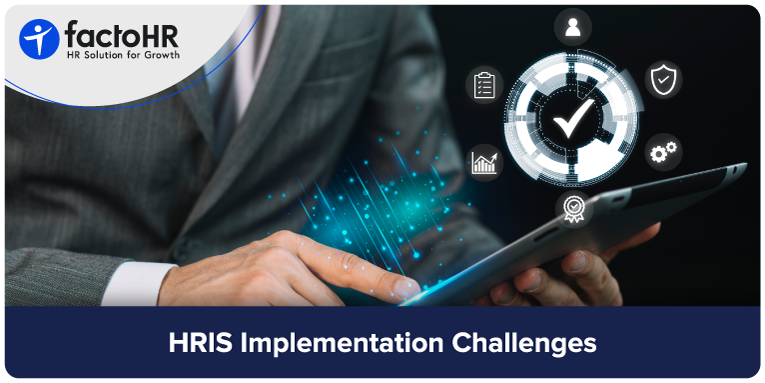How to Overcome HRIS Implementation Challenges?

Table of Contents
Human Resource Information Systems (HRIS) are systems that enable organizations to manage employee data across their entire operations. However, implementing an HRIS system requires strategic planning, as numerous challenges may arise.
For example, your organization will have massive data on employees from different departments. Now you need not just to manage the migration to the new HRIS system but also ensure it’s secure and there are no leakages. Maintaining security, lowering data loss, and recovery post-migration can be challenging.
Similarly, there are many HRIS implementation challenges that you may face, but this article offers solutions.
It will help you understand HRIS implementation challenges and proven strategies to overcome them with confidence.
Let’s break down the challenges first.

What are the Common HRIS Implementation Challenges to Overcome?
If you want to implement HRIS, your organization may face many challenges. CHROs and HR managers at your organization need to handle data issues. Below are six common HRIS implementation challenges, along with practical steps to overcome them. Each challenge is briefly explained, followed by steps to provide solutions that help you avoid common HRIS software issues.
Data Migration and Integrity
Migrating existing employee data into a new HRIS system often surfaces data quality issues. Outdated records, duplicates, or inconsistent formats can corrupt the new system. This leads to payroll and reporting errors. If inaccurate or incomplete data is used for HR processes, it can lead to significant errors. It’s essential to audit and clean your data before go-live.
- Audit and clean existing data: Conduct a thorough review of current HR data. Identify duplicate data, inconsistencies, and missing information, and standardize formats. Involve the HR and IT teams to verify critical fields.
- Validate through test migrations: Run trial migrations on the demo version of HRIS to check for errors in advance. Rigorously test payroll and benefits data for accuracy at each stage.
- Define clear data standards: Establish consistent naming conventions and standardized data formats. This reduces errors during migrations and helps overcome key challenges in HRIS implementation.
- Perform staged migration: Migrate data in phases, isolate issues, and back up all data before each phase. Back-up and rollback plans ensure you can recover if something goes wrong during the transition.
User Adoption and Training
Even the best HR system fails if staff don’t use it appropriately. Resistance to change and inadequate training are significant challenges to HRIS implementation. Employees accustomed to old processes may hesitate to learn a new HRIS. Plus, inadequate support can fuel frustration among employees.
Here are some solutions,
- Communicate benefits clearly: Explain how the HRIS software will simplify employees’ jobs. Highlight faster processes, such as instant payments and salary slip generation.
- Role-based training: Offer role-specific training and development resources. Arrange workshops, provide how-to guides, and hands-on demos on how to use HRIS systems.
- Phased rollout: Start with a pilot group of enthusiastic employees who can learn early and advocate for the system. Appoint “HRIS champions” who help their peers. This builds momentum and spreads positive feedback.
- Monitor usage and feedback: Track system usage and gather user feedback after launch. Adjust training materials and provide additional support where adoption lags.
Budget Constraints
Tight budgets and unexpected expenses often affect HRIS implementations. To stay on budget, carefully plan for a total cost of ownership (TCO). It includes the calculation of HRIS implementation, customization, and integration costs.
- Set a realistic contingency: Always include a buffer (10–20% of budget) for overruns. Negotiate fixed-price contracts for implementation or milestones to limit surprise charges if possible.
- Prioritize key features: If the budget is tight, focus on core HR functions first, such as payroll and leave. Avoid less critical custom features. This phased approach can spread costs over time and deliver value sooner.
- Monitor spending regularly: Track expenses against the budget at each stage of the project to ensure alignment with the budget. Utilize a project management tool or dashboard to identify overruns promptly. Regular financial reviews help you identify and eliminate non-essential costs quickly.
Customization and Scalability Issues
Every organization wants the system to fit its unique processes, but excessive customization can cause delays. At the same time, an HRIS must be able to scale to support your organization’s growth.
- Limit custom changes: Define and prioritize must-have custom features carefully to ensure they are implemented effectively. Too much coding increases complexity and cost. Focus on aligning the HRIS with your most critical needs. Avoid unnecessary customization that delays the project.
- Choose a modular solution: Select an HRIS that offers configurable modules or plug-ins. Modular platforms let you add new capabilities without heavy coding. For example, many systems allow you to enable fields or workflows without programming.
- Growth plan: Utilize cloud-based or scalable architectures to enable the system to handle an increasing number of users and data. Cloud HRIS solutions automatically expand capacity and reduce hardware costs. Ensure the vendor’s roadmap and pricing allow you to add users, departments, or features as you grow.
- Regularly review capacity: Monitor system performance and capacity as your organization grows. Check metrics (load times, data volume, number of users) and upgrade resources or licenses before bottlenecks appear. Involving your vendor early is crucial if you foresee significant growth.
Integration with Existing Systems
Integrating an HRIS platform with payroll, time-tracking, ERP, or benefits platforms can be a complex process. Mismatched data formats or a lack of APIs often cause delays. Without smooth integration, you’ll face manual workarounds that defeat the purpose of automation.
- Assess compatibility early: Before selecting an HRIS, map out all systems that need to be connected. Check data formats and integration methods (APIs, connectors, file feeds). Plan how employee records, time data, and financial info flow between systems.
- Engage IT experts: Collaboration between HR and IT is critical. IT can set up middleware or custom APIs and ensure secure data links. According to best practices, involving IT specialists helps “navigate the complexities” and address integration challenges promptly.
- Utilize integration tools: Many modern HRIS platforms offer pre-built connectors or third-party integration platforms as a service (iPaaS). Leverage these to simplify data mapping. For example, standard REST or SOAP APIs can synchronize data in real-time.
- Test each interface thoroughly: Treat each HR integration as its own project. Perform end-to-end testing of data flows. Catch errors on sample data before going live. Continuous monitoring post-launch will help identify and rectify any data mismatches promptly.
Compliance and Security Concerns
An HRIS holds sensitive employee data and must comply with labor laws. Breaches or non-compliance can be extremely costly. HR managers must ensure that robust security measures are in place and stay current with relevant regulations.
- Enforce data security standards: Protect personal data with encryption and role-based access controls. HRIS systems are “prime targets” for data breaches due to the sensitive data stored there. Use multi-factor authentication and regular security audits.
- Stay current with regulations: Integrate features that support legal compliance and ensure ongoing compliance. In many regions, statutory payroll and labor laws are updated on an annual basis. Ensure your HRIS vendor provides regular updates or configurable rules that enable the system to enforce current compliance requirements.
- Document processes and policies: Develop precise data handling and privacy policies. Train your HR and IT teams on security best practices. Maintain audit trails and logs in the HRIS to demonstrate compliance during audits and inspections.

Final Words
Data migration, user-adoption issues, integration, compliance concerns, and budget constraints can be challenges of HRIS implementation. Strategic planning, cross-functional collaboration, and unambiguous communication can help overcome these challenges.
As the HR Manager or CHRO, you must ensure that training is provided to facilitate proper implementation and that HRIS implementation aligns with business objectives. Through implementation with the required approach, the organization can create a human resources department that is more efficient, secure, and expandable.
FAQs
How to Implement an HRIS?
There are several critical steps in an HRIS process: assessing needs, selecting the right software, transferring clean data, integrating systems, and educating users. A well-crafted implementation plan sets the stage for a seamless launch of a Human Resource Information System. Below is a complete manual on implementing an HRIS, outlining each step through the process.
What are the Risks of HRIS Implementation?
HRIS implementation risks include:
- Data integrity issues due to poor migration.
- User resistance is due to a lack of training.
- Unexpected costs and overruns.
- Security vulnerabilities exist if data protection isn’t prioritized.
- Disruption to workflows if integration fails or the system is overly customized.
Proactively addressing these risks with a strategic plan and expert support reduces their impact.
What is the Negative Impact of HRIS?
While HRIS systems offer many benefits, poor implementation can result in:
- Employee dissatisfaction can arise from a system that is confusing or non-intuitive.
- Compliance gaps occur if statutory rules aren’t correctly configured.
- Increased workload from manual fixes when integrations fail.
- Financial loss if hidden costs emerge post-implementation.
These risks underscore the importance of selecting the right HRIS and meticulously planning each phase.
Grow your business with factoHR today
Focus on the significant decision-making tasks, transfer all your common repetitive HR tasks to factoHR and see the things falling into their place.

© 2025 Copyright factoHR


